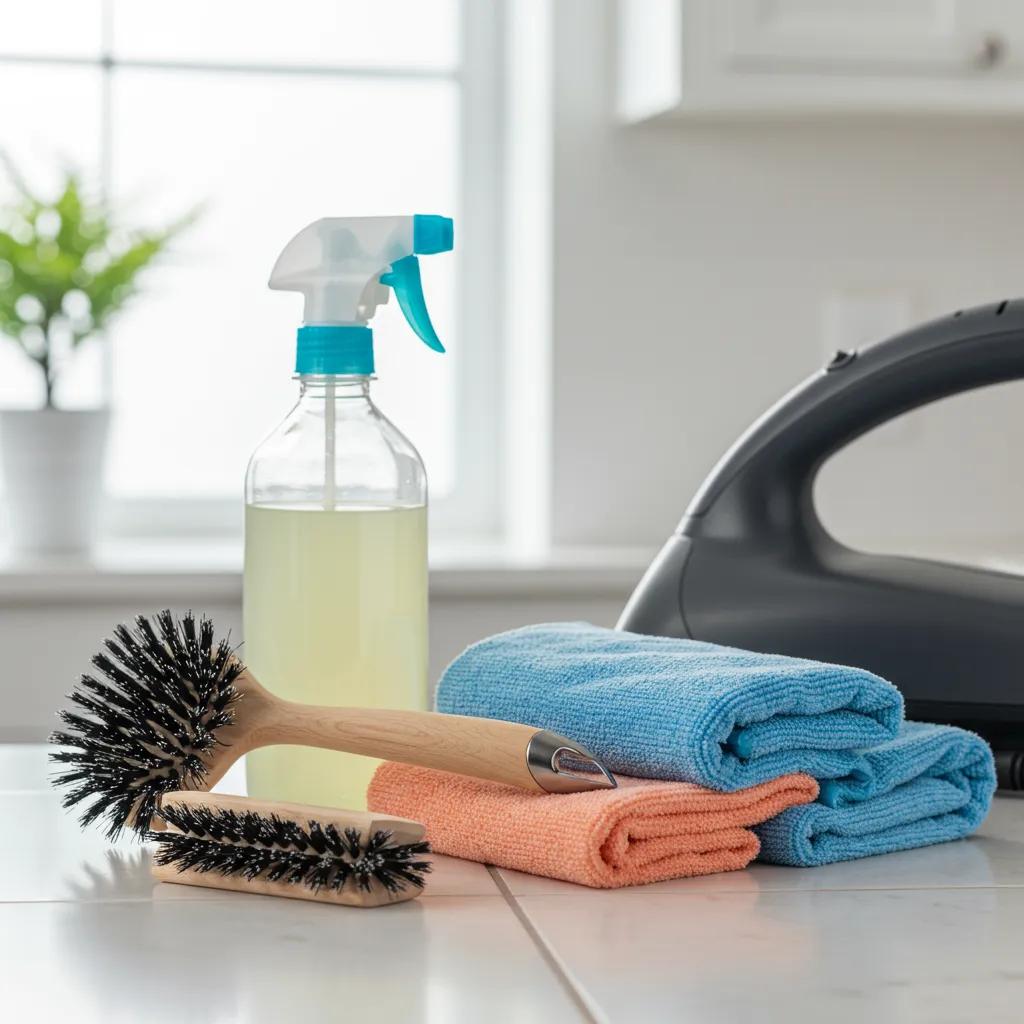Keeping your grout lines looking sharp and staying strong is key to making your tiled spaces in kitchens, bathrooms, and businesses look great, stay hygienic, and last longer. Homeowners often battle tough stains, pesky mold, and grout that starts to crumble. This not only ruins the look but can also become a breeding ground for germs and moisture, posing health risks. This guide is packed with grout care advice for homeowners, covering everything from grout types and common issues to easy DIY cleaning methods, smart sealing techniques, when to call in the pros for tile and grout cleaning, how often to do maintenance, how to spot problems, and what to expect cost-wise. You’ll learn how to tell cement-based grout from epoxy grout, get rid of that cloudy grout haze, stop mildew in its tracks, apply sealers like a pro, and know when it’s time to find a local tile cleaning service in Littleton or Lakewood, CO. By following these grout care tips, you can seriously upgrade your home’s tile and grout cleaning routine and ensure your surfaces are protected from stains and damage for years to come.
What Kinds of Grout Are There, and Why Do They Need Looking After?
Cement-based grout and epoxy grout are the two main types of stuff used to fill tile gaps. Each has its own quirks that affect how often you need to clean it, whether it needs sealing, and how tough it is over time. Cement-based grout is porous, meaning it needs regular sealing. Epoxy grout, on the other hand, isn’t porous and naturally fights stains, but it needs special cleaning products. Knowing if your grout is porous, how long it takes to set, and what kind of care it needs helps homeowners pick the right cleaning approach and sealing schedule for their ceramic, porcelain, or natural stone tiles.
What Exactly Are Cement-Based and Epoxy Grout?
Cement-based grout is made from cement, sand, and other bits and pieces. It’s easy to work with and comes in tons of colors. Epoxy grout, however, is made from epoxy resins and fillers, making it super resistant to stains and hardly absorbing any water.
| Grout Type | What It’s Made Of | How Porous It Is | How Often to Maintain | Where It’s Typically Used |
|---|---|---|---|---|
| Cement-Based Grout | Cement, sand, additives | Very porous | Seal every 6–12 months | Home floors, walls, showers |
| Epoxy Grout | Epoxy resin, inert fillers | Barely porous | Clean with gentle, pH-neutral cleaners | Busy commercial kitchens, high-traffic zones |
This quick chart shows how the stuff grout is made of and how porous it is really changes how you need to care for it. This leads us to talk about why porosity matters so much for cleaning and how long it lasts.
How Does Grout Porosity Impact Cleaning and Durability?
How porous your grout is determines how easily liquids, grease, and dirt can soak into the lines. Grout that’s very porous, like cement-based types, will grab onto stains faster and needs regular sealing to keep its color. Grout that’s not very porous, like epoxy, pushes water away and fights off germs, but using the wrong cleaners can actually damage its resin structure. Picking a cleaner that’s right for your grout’s porosity helps keep it strong and working well, especially in damp areas.
Why Is Regular Grout Upkeep a Must for Homeowners?
Keeping up with your grout maintenance stops it from breaking down, prevents mold from growing, and keeps your grout color looking good and your tiles stuck tight. This protects both your health and your home’s value. If you skip grout line care, moisture can sneak in, weakening how well your tiles are attached and creating perfect spots for mold or mildew. Setting up a regular routine of cleaning, sealing, and checking your grout helps your tiles last longer and means you won’t have to face expensive grout replacement jobs later on.
What Are the Usual Grout Headaches Homeowners Deal With?
Grout lines often end up with stains, mold, cracks, and a cloudy film when they’re exposed to everyday spills, steamy air, and harsh cleaners. Spotting these problems early means you can tackle them with the right fixes—from stain removal tricks to fixing cracks—bringing your grout back to looking and working its best.
How to Spot and Erase Grout Stains Effectively?
Grout stains show up as dark patches, yellowing, or colored marks from spills and foot traffic. To get rid of them, you need a mix of gentle scrubbing and the right cleaning stuff:
- Make a paste of baking soda and water. Use it to lift surface discoloration with its mild alkaline power.
- For tough organic stains, put hydrogen peroxide straight onto them to break down dark colors.
- If you have greasy spots, a store-bought grout cleaner with special ingredients will cut through the grease without harming the grout lines.
These targeted stain treatments bring back a uniform look to your grout and get it ready for protective sealing.
What Causes Mold and Mildew in Grout, and How Can You Stop It?
Mold and mildew thrive in damp, poorly aired grout lines where soap scum and food bits gather. To keep these growths away:
- Make sure your bathrooms and laundry rooms have good airflow.
- Wipe down tile surfaces after showers to get rid of extra moisture.
- Apply a penetrating grout sealer to block water from getting in and stop mold spores from taking hold.
By managing moisture and sealing regularly, homeowners can cut down on mold and keep the air in their homes healthier.
How to Fix Cracked or Worn-Out Grout?
Cracked grout means your tiles might not stick as well and water can get behind them, potentially damaging the floor underneath. Fixing it involves these steps:
- Use a grout saw to carefully remove the damaged grout, exposing clean edges of the joint.
- Clean the joints really well to get rid of all dust and gunk.
- Mix up new grout, making sure to match the color of the old grout. Then, use a grout float to press it firmly into the joints.
- Wipe away any cloudy residue from the tile surface with a damp sponge and let it dry completely before sealing.
Fixing cracks quickly keeps the grout strong and stops bigger problems from popping up.
What Is Grout Discoloration, and How Do You Get Rid of Grout Haze?
Grout discoloration can mean uneven colors from bad cleaning jobs or efflorescence—that chalky white stuff that comes from salts in the grout. Grout haze looks like a thin layer of cement dust on your tiles. To clear it up:
- Rub the tile surface with a grout haze remover or a diluted vinegar solution.
- Rinse everything off thoroughly and use a damp cloth to neutralize any leftover acidity.
- Finish up with a cleaner that has a neutral pH and dry the edges of the tiles.
Getting rid of haze and efflorescence reveals the true color of your grout and makes your tiles shine.
What Are the Best DIY Grout Cleaning Methods for Homeowners?
DIY grout cleaning lets homeowners handle minor grout issues using common household items and basic tools. When done right, these methods can refresh your grout lines affordably and sustainably.
Which Natural Cleaners Are Best for Grout?
Natural cleaners are great for removing stains and odors from grout tiles without harsh chemicals:
| Cleaning Product | How It Works | Best For |
|---|---|---|
| Baking Soda | Gentle scrubbing with alkaline power | Light stains and getting rid of smells |
| Vinegar | Acetic acid breaks down grime | Removing haze from ceramic and porcelain tiles |
| Hydrogen Peroxide | Oxidizes organic matter | Dark mold or mildew spots |
These earth-friendly options clean grout effectively without nasty chemicals, making your home safer for your family.
What Tools and Techniques Work Best for DIY Grout Cleaning?

Successful DIY grout cleaning comes down to using the right tools and methods:
- A stiff nylon grout brush lets you scrub right on the grout lines without causing damage.
- A spray bottle helps you apply cleaning solutions evenly along the grout.
- Microfiber cloths are great for soaking up loosened dirt and drying surfaces fast.
- A steam cleaner uses hot vapor to lift out deep-down dirt without needing any chemicals.
Using these tools with the right technique ensures your grout gets a thorough refresh and is ready for sealing.
When Is DIY Grout Cleaning a Good Idea, and When Should You Call a Pro?
DIY grout cleaning is perfect for light to moderate stains, keeping mildew at bay, and for homeowners who like to get hands-on with maintenance. You should consider calling a professional when:
- Grout discoloration is all over the place or deeply set in.
- Cracks are wider than 1/16 inch or you can see damage to the surface underneath.
- You have different types of grout, like epoxy, that need special cleaning gear.
Knowing these limits helps homeowners decide when professional tile and grout cleaning services will give them the best, most lasting results.
How and Why Should You Seal Your Grout?
Sealing your grout adds a protective layer that keeps water, oils, and stains out. This makes your grout last longer and makes cleaning much easier.
What Are the Benefits of Sealing Grout for Long-Term Care?
Sealing grout makes it better at resisting stains, absorbs less moisture, and cuts down on germ growth. Sealed grout keeps its color looking consistent and stops grout lines from becoming magnets for dirt and mildew. This means less frequent cleaning and better protection for your tile adhesion.
How Often Should You Reseal Grout for the Best Results?
Grout sealers usually need to be reapplied every 12 to 24 months. This depends on how much you use the tiles and the environment. Areas that get wet a lot, like showers, might need resealing every year, while floors with less traffic can go up to two years. Keeping up with this schedule maintains the sealer’s effectiveness and keeps your grout protected.
What Are the Different Types of Grout Sealers, and How Do You Pick the Right One?
There are two main types of sealers that work for different grout jobs:
| Type of Sealer | Penetrating Sealer | Surface Sealer |
|---|---|---|
| How It Works | Sinks into the grout pores to block moisture from the inside | Creates a protective film on the grout’s surface |
| What It Does Well | Looks natural, lets grout breathe while protecting it | Adds shine, easy to reapply |
| Best For | Porous cement-based grout in showers and on floors | Colored grout or decorative tiles |
Choosing a penetrating sealer for wet areas and a surface sealer for decorative projects ensures your grout gets the right kind of protection.
How to Apply Grout Sealer: A Step-by-Step Guide for Homeowners
Sealing grout involves these clear, sequential steps:
- Make sure the grout is completely dry and free of any dust.
- Use a small brush or roller to apply the sealer, making sure to cover all the grout lines.
- Wipe off any sealer that gets on the tile faces within two to five minutes.
- Let the sealer dry for a full 24 hours before getting the surfaces wet.
Applying it carefully helps the sealer soak in properly and provides even protection.
What Are the Perks of Professional Tile and Grout Cleaning Services?
Professional grout cleaning services use top-notch equipment, certified pros, and powerful cleaning solutions to get results that are deeper and last longer than what you can usually do yourself.
How Do Pros Clean Grout Differently Than DIY Methods?
Certified technicians use high-pressure steam and special spinning scrubbers that get deep into the grout pores, removing built-up dirt much better than scrubbing by hand. Their industrial-strength cleaners are made for specific grout types, dissolving stains without harming the grout or the tile’s finish.
The creation of special cleaning tools and products is super important for keeping grout in good shape.
What Can Homeowners Expect During a Professional Grout Cleaning Service?
When you hire professionals, they will:
- First, check your grout and test its moisture level.
- Choose cleaning solutions that are just right for your grout type.
- Use special equipment to pull out dirt and bring your grout lines back to life.
- Suggest and apply a top-quality grout sealer for ongoing protection.
This organized approach ensures your grout gets a complete makeover and expert care at every step.
Why Pick Sunny Carpet Cleaning for Grout Care in Littleton and Lakewood, CO?
Sunny Carpet Cleaning has certified grout experts who know all about the local water hardness and tile material challenges. Our green cleaning solutions and satisfaction guarantee give you peace of mind. Plus, our clear pricing and quick scheduling make the whole process easy. Trust our advanced gear and 20 years of experience to boost your grout’s health, looks, and your home’s value.
How to Keep Grout Healthy: Scheduling and Routine Care Tips for Homeowners
Setting up a proactive maintenance plan keeps your grout strong, clean, and looking good all year round.
What’s the Best Grout Maintenance Schedule for Kitchens and Bathrooms?
A schedule of cleaning every three months and sealing once a year strikes a good balance between effort and results:
- Kitchens: Clean grout every three months to handle spills and grease.
- Bathrooms: Wipe down and treat grout monthly to prevent mildew and soap scum.
- Seal grout once a year or after deep cleaning sessions.
Sticking to a consistent schedule keeps your grout performing well and reduces the need for intense deep cleaning.
How to Do Regular Grout Cleaning to Prevent Common Issues?
Regular grout cleaning stops dirt from building up and prevents germs from growing by:
- Wiping down tile surfaces and grout lines after you use them.
- Using cleaners with a neutral pH weekly to avoid damaging the grout.
- Scrubbing high-traffic areas with a grout brush every month.
These simple habits protect your grout’s condition and minimize stain formation.
What Are Eco-Friendly Grout Cleaning Solutions, and Why Are They Important?
Eco-friendly grout cleaning solutions use natural, biodegradable ingredients that reduce indoor air pollution and protect your family’s health. Products made with citrus extracts, non-phosphate surfactants, and plant-based enzymes clean effectively without harsh chemicals, supporting sustainable home care and lessening environmental impact.
What Are the Signs Your Grout Needs Immediate Attention?
Catching grout problems early prevents major damage and costly fixes.
How to Do a Grout Health Check at Home?
Look closely at your grout lines for these signs:
- Visible cracks or gaps in the joints that are wider than 1/16 inch.
- Dark spots that just won’t come out, no matter how much you clean.
- Crumbly or powdery residue along the edges of the grout.
- Water sitting on top of sealed surfaces.
Regular visual checks help homeowners catch issues before they get worse.
When Does Grout Damage Require Professional Repair or Replacement?
You’ll need professional help when grout damage includes:
- Structural cracks that expose the tile backing.
- Mold that keeps coming back even with good ventilation and sealing.
- Widespread efflorescence, which signals moisture getting in.
These serious signs indicate it’s time for expert grout repair or a complete re-grouting job.
What Are the Cost Factors for Grout Cleaning and Maintenance?
Figuring out the budget for grout upkeep means looking at the cost of professional services versus the price of DIY materials and your own time.
How Much Does Professional Tile and Grout Cleaning Usually Cost in Littleton and Lakewood?
Professional grout cleaning services in the Littleton and Lakewood area typically cost between $300 and $500 for a standard kitchen or bathroom. You might also see pricing from $1.50 to $3.00 per square foot. These prices depend on the grout’s condition, the size of the tiled area, and whether you add sealing services, ensuring you get clear estimates and care tailored to your needs.
What Are the Cost Savings of Regular Maintenance vs. Repair?
Putting money into regular grout maintenance saves you money in the long run by preventing major damage that would require a full re-grouting job.
- Annual maintenance costs are usually around $100–$200 for DIY sealers and cleaners.
- Emergency repairs and replacement can easily go over $800 when entire tiled areas need to be redone.
Taking care of things proactively cuts down on wasted materials, labor fees, and the hassle of big renovations.
What Are the Most Common Questions About Grout Maintenance?
Homeowners often ask about these topics, showing their common concerns about grout care:
| Question Topic | Type of Concern | What It’s About |
|---|---|---|
| How often to seal grout | Maintenance schedule | When to reapply sealer |
| Best cleaner for epoxy grout | Cleaning compatibility | pH level and product choice |
| How to stop mildew | Mold control | Ventilation and products |
| How to fix cracks | Structural integrity | Tools and materials needed |
| DIY vs. professional cleaning | Service decision | Comparing costs and benefits |
These common themes help homeowners find the right grout maintenance advice without needing immediate, detailed answers.
Keeping your grout healthy with smart cleaning, sealing, and checks preserves the beauty of your tiles and the hygiene of your home. Understanding grout types and how porous they are guides you to the right care methods. Proactive DIY routines help prevent stains and mold. When problems go beyond regular upkeep or involve structural issues, professional tile and grout cleaning services offer specialized solutions designed for Littleton and Lakewood conditions. Use these strategies consistently to protect your investment, improve your living space, and enjoy beautiful tile surfaces backed by expert grout maintenance support.



